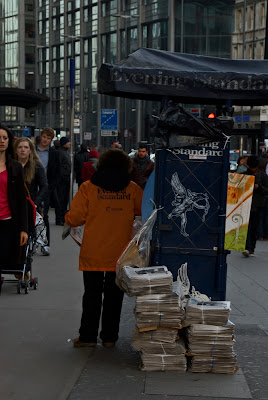The voice on the disc guides you through the streets towards Brick Lane and the surrounding area of Spitalfields with its rich and many-layered history. The area has witnessed waves of immigration over the centuries - Huguenots, Irish, Jews, Bangladeshis have all made their home here. As the sound of her footsteps echoes through the streets and in your brain, you realise that every step of the way you are treading in the paths of previous generations. "How can we just walk over the footsteps and not remember?" she asks, as she relates a story of a man who waited for 20 years for the woman he loved to return, all the while playing his violin in his room.
At every turn there is evidence of London's endless cycle of regeneration, the old cheek by jowl with the new. She wonders whether the construction workers are aware of their role as 'changers of the city, the men who cover up the old stories making room for new ones.' The tapping of her footsteps on the paving stones seem to emphasise the unfathomable immensity of the city - not just in its spread but in its depth, its layers reaching back far into time and resurfacing at odd moments in an architectural detail or an obscure place name. She observes that "The city is infinite. No-one has ever found an end to the pattern of the streets. Eventually the buildings reproduce themselves - a cornice that mimics another, a door that is the same colour as hundreds of others; every possible permutation - unlimited but cyclical."
This is what Peter Ackroyd refers to when he describes London as 'echoic' - the idea of the city as constantly reinventing itself, yet retaining its basic identity:
"It has been said that no stone ever leaves London but is reused and redeployed, adding to that great pile upon which the city rests. The paradox here is of continual change and constant underlying identity; it is at the core of the antiquarian passion for a continually altering and expanding city which nevertheless remains an echo chamber for stray memories and unfulfilled desires." (1)And as people pass through the labyrinth of streets, they leave traces of their presence behind them as they go....
"Keep walking past the newstand. Dead Woman Identified." she whispers.
With my imagination fired by the tangled web of narratives and multiple layers of sounds, my perambulations end fittingly in a nearby railway station - a repository of countless unknown stories, criss-crossing briefly but rarely coinciding. As she stands on the walkway looking down on the concourse, her voice muses "I like watching the people from here. All of these lives heading off in different directions, one story overlapping with another....."
I follow her instructions, but as I stand there with my camera and survey the scene, I notice that I have been spotted . I smile in a conciliatory way but three pairs of hostile eyes continue to return my gaze with such intensity, that I scuttle off and head for the tube. It seems ironic that in these days of constant surveillance and ubiquitous digital camera footage, the mere sight of a photographer with a camera in a railway station can provoke such suspicion.
(1) Ackroyd, Peter: London The Biography









No comments:
Post a Comment